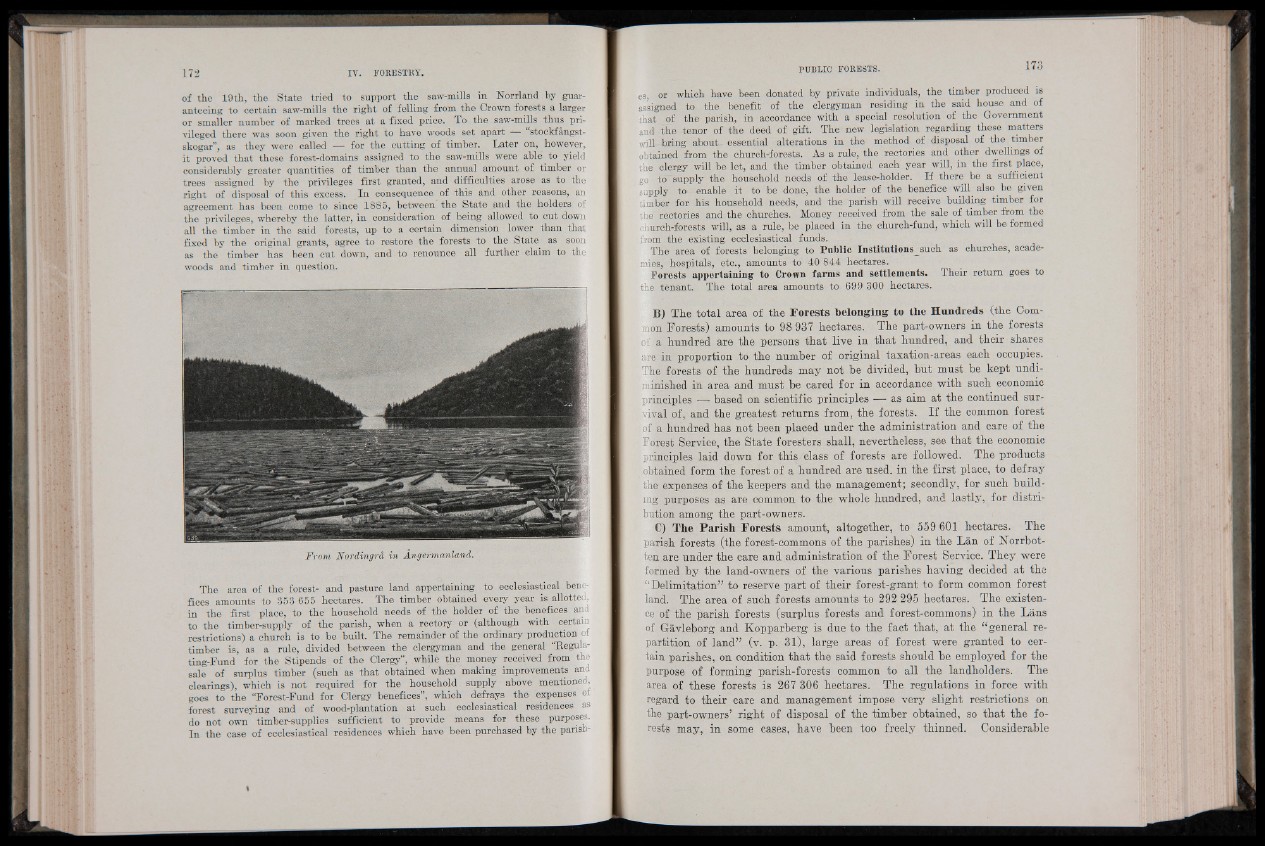
of the 19th, the State tried to support the saw-mills in Norrland by guaranteeing
to certain saw-mills the right of felling from the Crown forests a larger
or smaller number of marked trees at a fixed price. To the saw-mills thus privileged
there was soon given the right to have woods set apart - stockfangst-
skogar”, as they were called — for the cutting of timber. Later on, however,
it proved that these forest-domains assigned to the saw-mills were able to yield
considerably greater quantities of timber than the annual amount of timber or
trees assigned by the privileges first granted, and difficulties arose as to the
right of disposal of this excess. In consequence of this and other reasons, an
agreement has been come to since 1885, between the State and the holders of
the privileges, whereby the latter, in consideration of being allowed to cut down
all the timber in the said forests, up to a certain dimension lower than that
fixed by the original grants, agree to restore the forests to the State as soon
as the timber has been cut down, and to renounce all further claim to the
woods and timber in question.
From Nordingrâ in Angermanland.
The area of the forest- and pasture land appertaining to ecclesiastical benefices
amounts to 353 655 hectares. The timber obtained every year is allotted,
in the first place, to the household needs of the holder of the benefices and
to the timber-supply of the parish, when a rectory or (although with certain
restrictions) a church is to be built. The remainder of the ordinary production of
timber is, as a rule, divided between the clergyman and the general “Begula-
ting-Fund for the Stipends of the Clergy”, while the money received from the
sale of surplus timber (such as that obtained when making improvements and
clearings), which is not required for the household supply above mentioned,
goes to the “Forest-Fund for Clergy benefices”, which defrays the expenses of
forest surveying and of wood-plantation at. such ecclesiastical residences as
do not own timber-supplies sufficient to provide means for these purposes.
In the case of ecclesiastical residences which have been purchased by the parishes,
or which have been donated by private individuals, the timber produced is
assigned to the benefit of the clergyman residing in the said house and of
that of the parish, in accordance with a special resolution of the Government
and the tenor of the deed of gift. The new legislation regarding these matters
will bring about, essential alterations in the method of disposal of the timber
obtained from the church-forests. As a rule, the rectories and other dwellings of
the clergy will be let, and the timber obtained each year will, in the first place,
go i-to supply the household needs of the lease-holder. If there be a sufficient
supply to enable it to be done, the holder of the benefice will also be given
timber for his household needs, and the parish will receive building timber for
the rectories and. the churches. Money received from the sale of timber from the
church-forests will, as a rule, be placed in the church-fund, which will be formed
from the existing ecclesiastical funds.
The area of forests belonging to Public Institutionssuch as churches, academies,
hospitals, etc., amounts to 40 844 hectares.
Forests appertaining to Crown farms and settlements. Their return goes to
the? tenant. The total area amounts to 699 300 hectares.
B) The total area of the Forests belonging to the Hundreds (the Common.
Forests) amounts to 98 937 hectares. The part-owners in the forests
sf a hundred are the persons that live in that hundred, and their shares
are in proportion to the number of original taxation-areas each occupies.
The forests of the hundreds may not be divided, but must be kept undi-
I minished in area and must be cared for in accordance with such economic
principles j|§- based on scientific principles — as aim at the continued survival
of, and the greatest returns from, the forests. I f the common forest
^ of ia hundred has not been placed under the administration and care of the
Forest Service, the State foresters shall, nevertheless, see that the economic
principles laid down for this class of forests are followed. The products
obtained form the forest of a hundred are used, in the first place, to defray
the expenses of the keepers and the management; secondly, for such building
purposes as are common to the whole hundred, and lastly, for distribution
among the part-owners.
C) The Parish Forests amount, altogether, to 559 601 hectares. The
parish forests (the forest-commons of the parishes) in the Lan of Norrbot-
ten are under the care and administration of the Forest Service. They were
formed by the land-owners of the various parishes having decided at the
“Delimitation” to reserve part of their forest-grant to form common forest
land. The area of such forests amounts to 292 295 hectares. The existence
of the parish forests (surplus forests and forest-commons) in the Lans
of Gavleborg and Kopparberg is due to the fact that, at the “general repartition
of land” (v. p. 31), large areas of forest were granted to certain
parishes, on condition that the said forests should be employed for the
purpose of forming parish-forests common to all the landholders. The
area of these forests is 267 306 hectares. The regulations in force with
regard to their care and management impose very slight restrictions on
the part-owners’ right of disposal of the timber obtained, so that the forests
may, in some cases, have been too freely thinned. Considerable